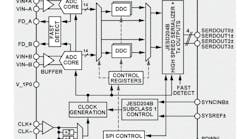Offering the opportunity for direct-conversion receiver and test-and-measurement architectures, model AD9680 is a dual-channel analog-to-digital converter (ADC) with effective input range of DC to 2 GHz. It features 14-b resolution with 1-GSamples/s sampling rate and on-chip buffer and sample-and-hold circuitry. The data converter delivers a spurious-free dynamic range (SFDR) of 85 dB at 340 MHz and 80 dB at 1 GHz, with signal-to-noise ratio (SNR) of 65.3 dB full scale at 340 MHz and 61.4 dB full scale at 1 GHz. The converter, with 95-dB isolation between channels, features low noise density of -154 dB/Hz full scale at 1 GSamples/s sampling rate and operates on voltage supplies of +1.25, +2.50, and +3.30 VDC. It is supplied in a 9-×-9 mm 64-lead lead-frame, chip-scale-package (LFCSP) housing and available with an evaluation board and reference designs to speed prototyping and layout.
Analog Devices, Inc., Corporate Communications Dept., Three Technology Way, Woburn, MA 02062; (800) 262-5643, (781) 329-4700
